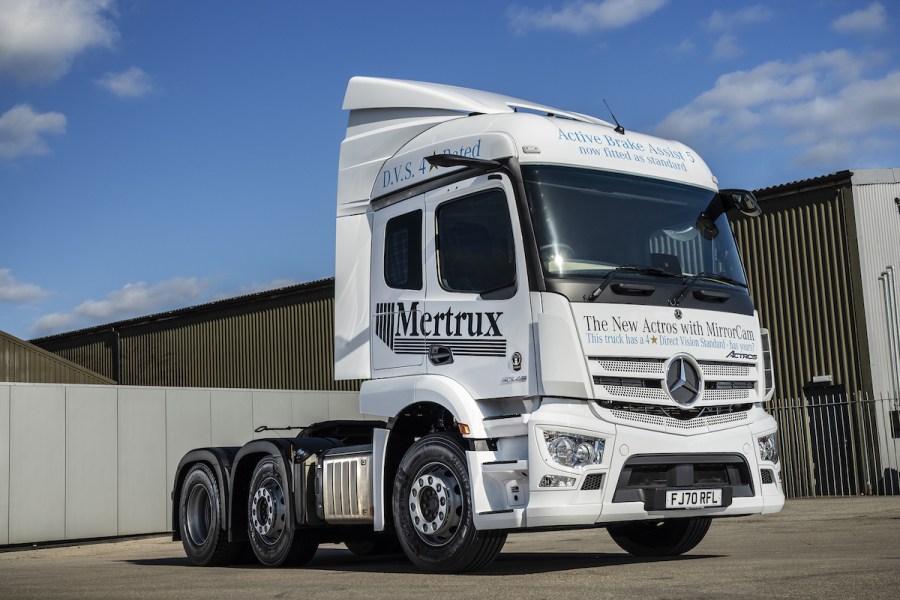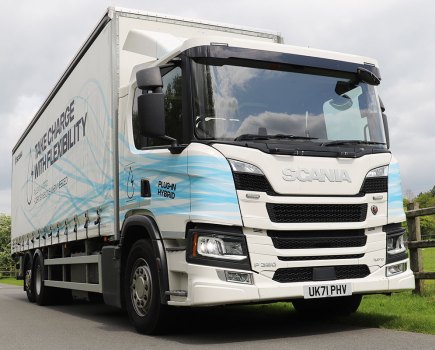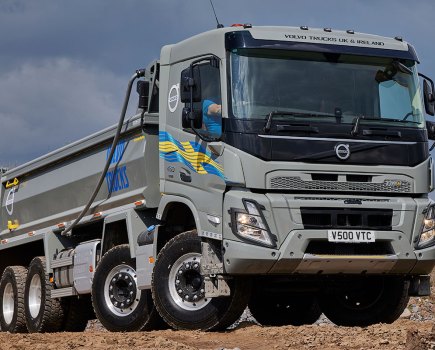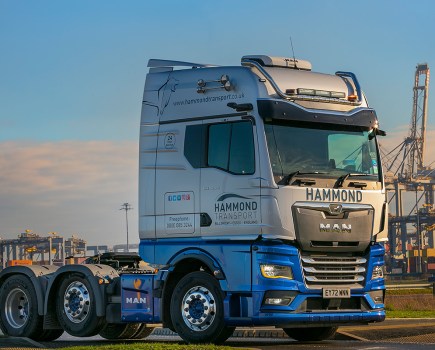We take a ‘supermarket trolley’, fewer-frills Merc Actros 2546 out for a shift and kiss and make up with the Predictive Powertrain Control. It’s actually quite good – once you use it properly!
When Mercedes-Benz introduced its new MirrorCam and Multimedia Cockpits, it was announced they wouldn’t be reserved for the biggest cabs and instead rolled out across the whole Actros and Arocs range.
At the launch, Trucking asked if the company thought this new state-of-the-art gadgetry would be a bit too daunting for the likes of supermarkets – especially learning lessons from the birth of the Actros back in the 1990s, which was shunned by fleets and rental companies as complex at the time and forced Merc to develop the no-frills basic Axor range.
But would Actros Version 5 be better off as a more basic option for the big fleets?
Well, the truth is Merc will still sell you a truck with conventional mirrors and even with a ‘classic’ dashboard should you want it. In fact, you can get any Version 5 Actros with both these features, although we challenge the truck enthusiasts to tell them apart from a Version 4 other than by registration plate.
But Merc is also confident the big fleets would indeed embrace the new technology. And from the trucks we’ve seen on the road, that seems to be the case.
Like every manufacturer, a new truck launch means the press get to test big trucks sporting all the bells and whistles. For Merc, that was a 2563 GigaSpace – and even later was an 1845 Big Space model.
All well and good, but what about the smaller trucks? The classic ‘Wendy house’?
This road test came about in strange circumstances. A friend who runs a small fleet of 15 or so trucks loves small cabs. He’s a big Scania fan, with a few P and G series in his yard, but he’s not averse to taking a Merc from time to time.
So when he was offered a 2546 with the small 2.3 m wide cab with the 320 mm engine hump, yet the most powerful version of the 10.7-litre straight-six at 455 bhp, he jumped at the chance. And he also offered us a chance to drive it, fully loaded on a shift. That was an offer too good to turn down.
Seeing our tweets about our overnight in the 2546, Mertrux, the dealer, then invited us for a day in the very same truck with its test trailer. So this is a test over two very different days.
Technical overview
Merc has three main engine sizes for the vast majority of its 38-44 tonne tractor units. First is the 10.7-litre OM470 at 326, 360, 394, 428 and 455 bhp – the latter three versions only really suitable for top-weight work. Then there’s the 12.8-litre OM471 available at 421, 449, 476, 510 and 530 bhp. There’s also the OM473 15.6-litre rated at 517, 578 and 625 bhp.
The 450 bhp bracket is one of the most popular for 44-tonne work and here Merc has two engines of two different sizes. As tested here, it’s the most powerful version of the smaller (and lighter) 10.7-litre and towards the lower end of the spectrum on the bigger lump. Torque on the OM470 in its highest form is 2200 Nm, which is the same as the 2545 with its bigger engine.
The transmission was Merc’s automated Powershift 3 with ratios from 14.93:1. The axles were rated at 7500 kg for both the front and mid-lift, and 11,500 kg for the drive axle. Tyres were 315/70R22.5 all round.
The truck was heavily laden with a host of safety features in addition to MirrorCam, including Active Brake Assist 5 with its autonomous emergency braking and pedestrian recognition. It also came fitted with Traffic Sign Assist, Attention Assist, Lane Keeping Assist, Proximity Control Assist and Stability Control Assist.
The truck had the high-roof, narrow StreamSpace L-cab, which is the lowest entry available in the Actros range. This means it has a 320 mm engine hump. The ClassicSpace and (narrow) StreamSpace have the 170 mm engine hump, while the GigaSpace, BigSpace and (full-width) StreamSpace have a flat floor.
What that means is there is enough room (just) to stand up in the passenger footwell to get changed. There is even room for a second bunk. But the truth is this is a cab for occasional nights out; were you to offer it to one of your trampers, chances are they’ll start looking to take their services elsewhere.
The new Version 5 gizmos were present and correct: that snazzy and very usable Multimedia Cockpit, MirrorCams and the facility to dump your smartphone in a tray and let it charge without a dangly cable getting in the way.
On the road
Many hauliers we’ve spoken to have mentioned they’ve found Mercs to be a bit gutless, and in some of our road tests the 2545s have seemed to struggle. It’s why many Merc aficionados prefer the 2548 or 2551 models; it’s not just to be power-crazy, but rather they find the extra grunt is worthwhile.
So with this in mind, we were intrigued to see how the 2546 with a little engine working at its hardest would compare.
Our day started in Spalding with a full load for Hemel Hempstead, then it was empty to Ely to reload for home – a distance of 235 miles. Once we’d got our loaded trailer, it was it onto the road. We took the A16 towards Peterborough, skirted round the city on the A1139 and then joined the A1M southbound. Then it was the A421 past Bedford to join on the M1 southbound for the run towards Hemel.
All in all, it was straightforward – and despite a full load, the truck was doing pretty well. As you might expect, the truck takes its time to get up to full speed, but once there it was simply a case of using the CC, sitting back and enjoying the ride.
We’ve driven MirrorCam Mercs a fair bit now, and there’s not too much we don’t like about the system. While the images are a bit grainy in the dark, they are no worse than normal mirrors. In fact, the week after the first time we drove a mirrorless Merc in the dark, we took charge of a conventionally mirrored Scania and all we could see in the main mirror was a reflection of the brightly lit dash.
You don’t get that with MirrorCam – so this case, it’s a better system.
At Hemel, we were told which bay to back on. It was the only spare bay and was quite tight. With MirrorCam, we could see the back of the trailer at all times, which made the process much simpler.
Unloaded, it was off to Ely to reload, and getting diverted off the A11 did us no favours. We got there with a couple of minutes to spare before our 45-minute break. This time there was lots more room to get on the bay, and again, the digital mirrors meant we didn’t have to leave the cab to check our positioning.
PPC predicament
The final leg, however, was where we had a little fall out with the Merc. The truck has Predictive Powertrain Control (PPC), which means it ‘reads’ the road ahead and slows you down for bends and roundabouts, and then accelerates away when the road straightens out again. It also reads speed limits, so it will slow you down for a 30 mph zone and speed up again when the zone is exited.
In principle, it’s a good system. We found it braked a little more than we might have done, but that’s OK – better safe than sorry.
But on roundabouts, the pull away was painfully slow. We could see the truck slowing down to 12, 10, even 9 mph and then taking an age to get going again. It got so frustratingly annoying that we simply started to put our foot down after every roundabout to prevent anyone behind getting understandably irate.
It seems we were partly right in this. The man from Mertrux told us it is a frustration, and it’s because the truck “hasn’t quite worked out” that it’s off the roundabout and can get going again. So while we were right to apply power, all we needed to do was literally tap the accelerator to let the truck ‘know’ it’s time to get a wiggle on, and watch it speed up.
On our test drive with Mertrux, we did just that and the truck behaved as we wanted – and soon it became all the more relaxing for it.
PPC is an acquired taste and not all drivers will like it. However, it does make the truck drive in the most fuel-efficient way – and if you are paying the diesel bills, or are on a fuel bonus, that’s worth remembering.
VERDICT
Mercedes has been a big player in the no-frills fleet market for some time and developed the venerable Axor purely for the lucrative UK market. It succeeded with its bulletproof basic gaffer’s motor with some massive orders for the likes of Tesco.
The small Actros followed that success, and now the Version 5 are bringing an element of technology to what was previously a pretty basic truck.
This 2546 has a lot going for it. It handles nicely, it doesn’t seem to have that sluggishness the 2545 suffers from, perhaps because the 10.7-litre working hard seems to be more responsive.
On our first drive of 235 miles, it delivered a very impressive 10.72 mpg according to the Fleetboard. On the second drive of 110 miles, with a tipper trailer loaded to 44 tonnes, the average was 8.54 mpg. Considerably less, but the route was more single-carriageway driving with more hills and bends, very limited use of the CC and also at a higher gross weight. Again, it’s not a bad figure at all.
We’re big fans of MirrorCam. Once you get used to it, the Multimedia Cockpit is also a winner. It’s crisp and clear and multi-functional. We still have reservations about the secondry screen at times, which can sometimes be a bit distracting. But those drivers who use it day-in, day-out will soon get used to it and either set it up the way they want before pulling off, or make use of the buttons below the screen instead.
The buttons on the steering wheel also take some getting used to; but once you do, they are fine. The electric parking brake is a bit Marmitey and there is the odd occasion it just didn’t seem to be that responsive. Many drivers still prefer a good-old manual parking brake, and we can see why.
PPC is the biggest thing which will please or infuriate drivers. And here again, the message is simple: don’t dismiss it out of hand. Try it out, get to use it and, more importantly, learn how to use it properly. When stepping into a Version 5 Merc for the first time, you need a proper handover. Mercedes suggests at least half a day, and we agree with that. There is a lot to take in.
Overall, this was a nice truck. It’s not spectacular; it’s just a simple, honest working truck that will shift a decent load and earn you a decent wage. It’s got lots of technology, and you need to learn how to use it to make it work best for you!
We like:
- MirrorCams
- Build quality
- Easy access
- Superb roadholding
We don’t like:
- PPC takes getting used to
- Second screen is still a distraction






